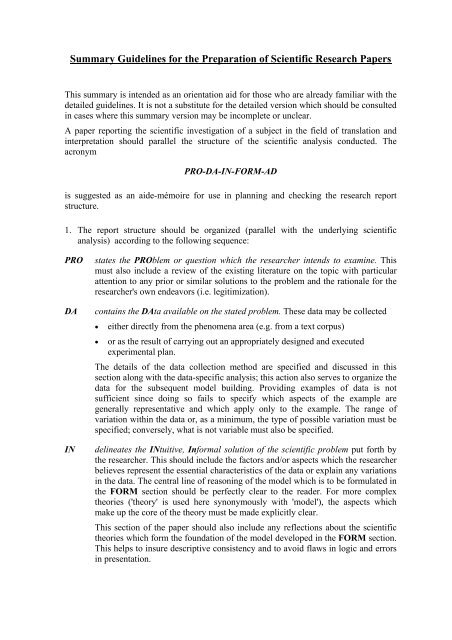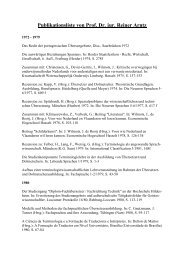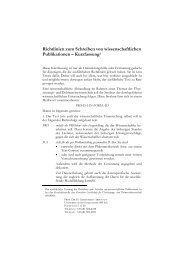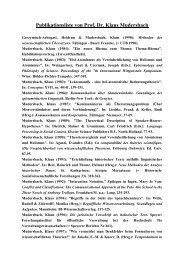Summary Guidelines for Preparation of Scientific Papers
Summary Guidelines for Preparation of Scientific Papers
Summary Guidelines for Preparation of Scientific Papers
Create successful ePaper yourself
Turn your PDF publications into a flip-book with our unique Google optimized e-Paper software.
<strong>Summary</strong> <strong>Guidelines</strong> <strong>for</strong> the <strong>Preparation</strong> <strong>of</strong> <strong>Scientific</strong> Research <strong>Papers</strong><br />
This summary is intended as an orientation aid <strong>for</strong> those who are already familiar with the<br />
detailed guidelines. It is not a substitute <strong>for</strong> the detailed version which should be consulted<br />
in cases where this summary version may be incomplete or unclear.<br />
A paper reporting the scientific investigation <strong>of</strong> a subject in the field <strong>of</strong> translation and<br />
interpretation should parallel the structure <strong>of</strong> the scientific analysis conducted. The<br />
acronym<br />
PRO-DA-IN-FORM-AD<br />
is suggested as an aide-mémoire <strong>for</strong> use in planning and checking the research report<br />
structure.<br />
1. The report structure should be organized (parallel with the underlying scientific<br />
analysis) according to the following sequence:<br />
PRO<br />
DA<br />
IN<br />
states the PROblem or question which the researcher intends to examine. This<br />
must also include a review <strong>of</strong> the existing literature on the topic with particular<br />
attention to any prior or similar solutions to the problem and the rationale <strong>for</strong> the<br />
researcher's own endeavors (i.e. legitimization).<br />
contains the DAta available on the stated problem. These data may be collected<br />
• either directly from the phenomena area (e.g. from a text corpus)<br />
• or as the result <strong>of</strong> carrying out an appropriately designed and executed<br />
experimental plan.<br />
The details <strong>of</strong> the data collection method are specified and discussed in this<br />
section along with the data-specific analysis; this action also serves to organize the<br />
data <strong>for</strong> the subsequent model building. Providing examples <strong>of</strong> data is not<br />
sufficient since doing so fails to specify which aspects <strong>of</strong> the example are<br />
generally representative and which apply only to the example. The range <strong>of</strong><br />
variation within the data or, as a minimum, the type <strong>of</strong> possible variation must be<br />
specified; conversely, what is not variable must also be specified.<br />
delineates the INtuitive, In<strong>for</strong>mal solution <strong>of</strong> the scientific problem put <strong>for</strong>th by<br />
the researcher. This should include the factors and/or aspects which the researcher<br />
believes represent the essential characteristics <strong>of</strong> the data or explain any variations<br />
in the data. The central line <strong>of</strong> reasoning <strong>of</strong> the model which is to be <strong>for</strong>mulated in<br />
the FORM section should be perfectly clear to the reader. For more complex<br />
theories ('theory' is used here synonymously with 'model'), the aspects which<br />
make up the core <strong>of</strong> the theory must be made explicitly clear.<br />
This section <strong>of</strong> the paper should also include any reflections about the scientific<br />
theories which <strong>for</strong>m the foundation <strong>of</strong> the model developed in the FORM section.<br />
This helps to insure descriptive consistency and to avoid flaws in logic and errors<br />
in presentation.
PRODAINFORMAD - <strong>Preparation</strong> <strong>of</strong> <strong>Scientific</strong> <strong>Papers</strong> (cont.)<br />
FORM elucidates the FORMal (i.e. algorithmically <strong>for</strong>mulated) model or theory. This<br />
does not mean the model or theory has be stated in <strong>for</strong>mal mathematical or logic<br />
symbols but that it must at least be presented in an orderly theoretical language<br />
which the expert reader can understand and follow and, if desired, utilize and<br />
further develop. Also included in this section is the introduction and explanation<br />
<strong>of</strong> definitions and terminology and the <strong>for</strong>mulation <strong>of</strong> the model in the proposed<br />
theses.<br />
AD<br />
represents the final verification <strong>of</strong> the ADequacy <strong>of</strong> the model and/or theory with<br />
reference to the questionings and the data: i.e. in which parts the research<br />
questions were satisfactorily answered and which data was appropriately<br />
described by the model. It must also be stated how the theoretical theses (and<br />
thereby the included terminology) are to be applied to the data. However, be<strong>for</strong>e<br />
this step is carried out it must be clearly demonstrated to the reader that the<br />
proposed theoretical solution is in fact a model <strong>of</strong> the proposed solution.<br />
The ideal situation and ultimate goal <strong>of</strong> every scientific investigation is always to describe<br />
all data with a theory and thereby completely answer all questions. The ideal, however,<br />
cannot be the only criterion <strong>for</strong> an acceptable answer. A partial answer, which explicitly<br />
establishes which data were described by the theory and which not also represents an<br />
increase in the state <strong>of</strong> scientific knowledge in the researched field.<br />
Further, indications <strong>of</strong> contradictions, complications and other problems which emerge<br />
from the proposed solution are also relevant since they pose new problems to be<br />
researched and thereby continue the upward spiral <strong>of</strong> development which advances science<br />
to the next level.<br />
2. The preparation <strong>of</strong> the research report can best be accomplished by applying the<br />
PRODAINFORMAD in the following phases:<br />
• Precondition <strong>for</strong> a scientific research paper: The absolute prerequisite <strong>for</strong> report<br />
production is the completion <strong>of</strong> the scientific analysis.<br />
• <strong>Preparation</strong> phase: In this phase the factual in<strong>for</strong>mation gathered is assigned to the<br />
PRODAINFORMAD phases.<br />
• Text <strong>for</strong>mulation planning phase: Texts should be planned with the intended type <strong>of</strong><br />
recipient in mind and factual in<strong>for</strong>mation <strong>for</strong>mulated according to their level <strong>of</strong><br />
scientific expertise in the field.<br />
• Text set-up phase: The <strong>for</strong>mulated text plan is trans<strong>for</strong>med into a text appropriate <strong>for</strong><br />
the intended recipients.<br />
• Control phase: The general structure <strong>of</strong> the text composition is checked against the<br />
PROADINFORMAD and the text coherence controlled.<br />
So far as possible, straight<strong>for</strong>ward and theoretically clear language should be used in all<br />
segments <strong>of</strong> the scientific treatment.<br />
• Stylistic variations, the use <strong>of</strong> synonyms <strong>for</strong> terms and flowery metaphors as well as<br />
complicated language should be avoided.<br />
2
PRODAINFORMAD - <strong>Preparation</strong> <strong>of</strong> <strong>Scientific</strong> <strong>Papers</strong> (cont.)<br />
• Comparisons, analogies, examples and anecdotal case studies are not substitutes <strong>for</strong><br />
well modeled statements but may be added to improve understanding. (Even if not all<br />
<strong>of</strong> the English-language scientific community subscribes to this position.)<br />
3. Every section <strong>of</strong> the PRO-DA-IN-FORM-AD should clearly state:<br />
• the partial task to be dealt with and/or the purpose and objectives <strong>of</strong> this part <strong>of</strong> the<br />
paper<br />
• how the objectives are achieved, i.e. methods, data, linguistic means (terminology,<br />
algorithms, etc.) as well as the lines <strong>of</strong> reasoning<br />
• which conclusions can be determined from each section.<br />
4. When tables and figures are used, all characters shown in the graphics (symbols, and<br />
abbreviations, etc.) must be clearly defined. It is also important to insure the<br />
relationship between every graphic and the text is transparent. (When a graphic<br />
contains more in<strong>for</strong>mation than explained in the text, it is unclear whether the text or<br />
the graphic is the basis <strong>of</strong> description.)<br />
5. Reflections on the principles <strong>of</strong> scientific theoretical thinking and how adhering to<br />
these principles influences in<strong>for</strong>mation structuring and helps to avoid logical errors are<br />
<strong>of</strong>fered in the detailed guidelines.<br />
Klaus Mudersbach<br />
(English version by Alfred Arbogast)<br />
3






